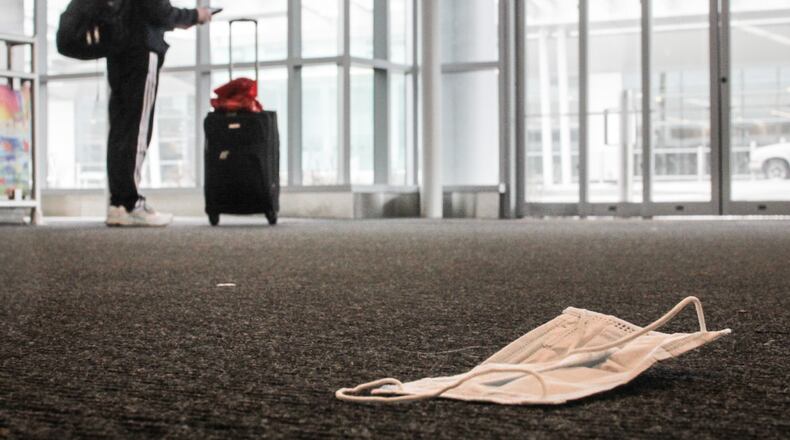The world will soon enter a fourth calendar year with COVID-19 as fears about the new Omicron variant loom. Many Dayton-region residents said they’re exhausted — they’ve tuned out information about the pandemic and let precautions like mask wearing lapse. Some also said they’re frustrated watching others not get vaccinated or follow precautions.
“It is really hard. There’s nothing that I would say to minimize anybody’s feelings about this,” said Dr. Valerie Weber, dean of the Wright State University Boonshoft School of Medicine. “After two years of this, in some ways, we’re expecting that things are going to go back to the way they were, and I just don’t think that they are, and I think that that’s hard for people to cope with.”
Weber cautioned that many people have grown accustomed to the pandemic and are not taking the danger as seriously as they should. After declining in October, cases and hospitalizations have climbed again, surpassing the peak seen during the fall wave.
More than 3,900 Ohioans, most of them unvaccinated, are currently hospitalized with COVID-19. The all-time state high was about 5,300 patients in December 2020.
“It’s a dangerous time this winter, especially if you’re not vaccinated,” Weber said. “But people are just done with it, and that’s going to get people in trouble. Last winter at this time and also now are the two most dangerous parts of the pandemic if you’re unvaccinated.”
About 58% of Ohioans have received at least one dose of the coronavirus vaccine.
Ohio State University Professor Graham Dixon, an expert in science and risk communications, said this pandemic fatigue people are experiencing after nearly two years was predictable. People feel bombarded with information and helpless to do anything, he said.
“People experience low efficacy when they feel they can’t do anything about an issue or they engage in information avoidance,” he said.
It can be difficult to communicate to the public why new science means guidance has to change, Dixon said. This includes bringing back masking or encouraging booster shots after many vaccinated people thought they were in the clear.
Dixon said it’s important for health leaders to continue to highlight what individuals can do to prevent the spread of the virus: get vaccinated (including a booster shot) and wear face masks in public, indoor settings.
People are tired of precautions
Neuhauser usually wears a mask in stores, but she said it can get tiring.
“Sometimes, I’ll be like, ‘Oh screw it, I’m in a hurry,’” she said.
Mask wearing has fallen significantly in the region since state and local mandates were lifted. Last November, a Dayton Daily News investigation visited over 100 area stores and observed nearly 2,000 customers, and found that nearly all were wearing masks.
One afternoon last week, more than half of the people inside stores at the Greene Town Center were not wearing face masks. At a grocery store in Huber Heights, unmasked shoppers outnumbered masked patrons 3 to 1.
Since July, the Centers for Disease Control and Prevention has recommended face masks in public, indoor settings regardless of vaccination status in counties experiencing high rates of transmission, meaning all of Ohio and about 70% of the country.
“Sometimes I do (wear a mask), just depending on where we’re going, but for the most part not really,” said Huber Heights-resident Megan Niese standing in a Walmart parking lot in Huber Heights.
Huber Heights-resident Allison Cornell’s husband has a heart condition that puts him at high risk for severe complications from COVID-19, so they still wear masks in public and take plenty of precautions.
“It is kind of exhausting, especially when you see some people that are not wearing masks, even when it’s suggested,” she said. “It does sometimes feel a little bit like I’ve been doing all the right things for 22 months, and we’re still having to deal with this new variant. There’s fatigue. It feels almost like an unfair burden that some people are carrying, versus some people who haven’t been masked and haven’t been vaxxed.”
John Lawson of Springfield said it is extremely frustrating to see other people not following scientists’ recommendations.
“I’m getting to the point now that those who are unvaccinated, they have their freedom, the freedom to pass on if they want,” he said.
Tuning out pandemic news
In spring of 2020, during the beginning of the pandemic shut downs in Ohio, Beavercreek-resident Dale Wissman said he consistently watched Gov. Mike DeWine and the Ohio Department of Health’s frequent broadcasts. He regularly followed pandemic news.
“But I haven’t paid any attention to it in a long time,” he said. “It’s probably fatigue as much as anything. You’re getting the same message over and over. I wish this would be over. I wish people would just get the vaccination and be done with it and move on. Dragging it out like this just seems ridiculous.”
Long gone are the days when watching DeWine and then-ODH Director Dr. Amy Acton’s daily press conferences was a popular pastime in Ohio — a time when jokes about afternoon wine with DeWine flowed, an Ohio animator made a playful theme song for the duo and even DeWine’s sign language interpreter, Marla Berkowitz, became a recognizable public figure in Ohio.
“Now, people are just getting bombarded with so much information, some information seems to be conflicting and produces a great deal of uncertainty and that can increase that feeling of low efficacy,” Dixon said. “People are just burned out from it. They are avoiding information and, unfortunately, it can lead people to engage in riskier health behaviors, like not wearing masks.”
To reach people, health leaders need to emphasize what we know can reduce the risk of infection and community transmission: masks and vaccinations, Dixon said.
Bracing for a marathon, not a sprint
It can be easy for those who have not been personally affected by the pandemic to forget how serious it remains. But people are dying every day, our economy is impacted and area health care systems continue to be taxed, Weber pointed out.
“If you think you’re fatigued from having to wear a mask, you should see how people that have been working in health care for the past two years are suffering from fatigue,” she said.
She said people need to view the pandemic as a marathon, not a sprint, and tell themselves to keep going.
“You’re doing it for yourself, your loved ones, for society. I think sometimes we’re a little bit too stuck on what we want as a person — this is how I want it to be. But in a civil society, we have to do things to help other people,” she said. “I guess I would just say adapt to it and just accept that it’s not the same as what it was, but it’s still pretty darn good. We have a lot of advantages in this country and I can do everything I want to, pretty much, just by putting a mask on my face and getting a vaccine.”
While shopping at The Greene wearing a mask decorated with peppermint swirls, Centerville-resident Pam Lubbers said she’s gotten used to taking pandemic precautions.
“It’s not that hard to throw on a mask in my opinion,” she said. “I have a stack of them by the door by my purse.”
About the Author


